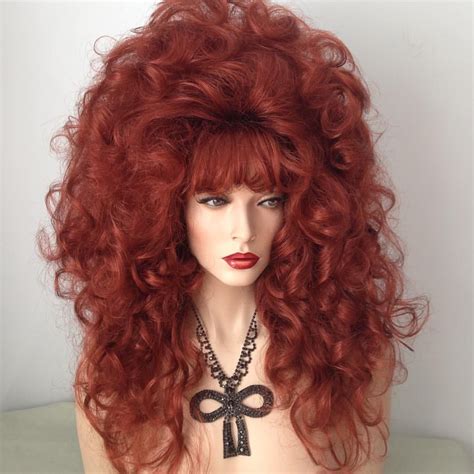Introduction
Drag queen wigs are an essential part of the drag performance experience. They help drag queens transform their appearance, create larger-than-life characters, and express their creativity. In this guide, we’ll explore the world of drag queen wigs, from the different types and materials to the techniques used to create them.

Types of Drag Queen Wigs
There are many different types of drag queen wigs available, each with its unique characteristics:
- Lace front wigs: These wigs have a delicate lace front that creates the illusion of a natural hairline. They are usually more expensive than other types of wigs but offer the most realistic look.
- Full lace wigs: These wigs are made entirely of lace and can be styled in any way imaginable. They are the most expensive type of wig but also the most versatile.
- Synthetic wigs: These wigs are made from synthetic fibers and are more affordable than human hair wigs. They are less durable but can still create a realistic look.
- Human hair wigs: These wigs are made from real human hair and offer the most natural look and feel. They are the most expensive type of wig but can last for many years with proper care.
Materials Used in Drag Queen Wigs
The materials used in drag queen wigs play a significant role in their appearance and durability:
- Human hair: Human hair wigs offer the most natural look and feel. They can be styled and colored just like real hair. However, they are more expensive and require more care than other types of wigs.
- Synthetic fibers: Synthetic fibers are less expensive than human hair and more durable. They are also more resistant to heat damage, making them ideal for styling with hot tools.
- Lace: Lace is used to create the realistic hairline on lace front and full lace wigs. It is a delicate material that requires careful handling.
Techniques for Creating Drag Queen Wigs
Drag queen wigs are not just wigs; they are works of art. Wig makers use a variety of techniques to create these fabulous creations:
- Bleaching: Bleaching is used to lighten the color of wigs, making them easier to dye.
- Dyeing: Dyeing is used to add color to wigs. Drag queens often use vibrant colors to create their signature looks.
- Styling: Styling is used to create the desired shape and volume of wigs. Drag queens often use hot tools, hairspray, and other styling products to achieve their desired looks.
The Art of Hairdramatics
Drag queen wigs are not just about aesthetics; they are also about performance. Drag queens use wigs to create larger-than-life characters and express their creativity. Wigs allow them to transform their appearance and embody different personas.
The Evolution of Drag Queen Wigs
Drag queen wigs have evolved over time, reflecting the changing trends in drag culture. In the early days of drag, wigs were often made from real human hair and were more traditional in style. Today, drag queens use a wider variety of materials and styles to create their wigs. They are more experimental and creative with their looks, using wigs to push the boundaries of drag.
The Psychology of Drag Queen Wigs
Drag queen wigs are more than just pieces of hair; they are symbols of identity and expression. They allow drag queens to experiment with their appearance and explore different aspects of their personalities. Wigs can also be used to express political or social messages.
The Significance of Drag Queen Wigs
Drag queen wigs are an important part of drag culture. They help drag queens create their signature looks, express their creativity, and connect with their audiences. Wigs are also a symbol of drag’s history and evolution.
Conclusion
Drag queen wigs are an essential part of the drag performance experience. They allow drag queens to transform their appearance, create larger-than-life characters, and express their creativity. From the different types and materials to the techniques used to create them, drag queen wigs are a fascinating and ever-evolving art form.
Common Mistakes to Avoid
When it comes to drag queen wigs, there are a few common mistakes to avoid:
- Choosing the wrong type of wig: Make sure to choose the right type of wig for your needs and budget. If you want a realistic look, opt for a lace front or full lace wig. If you’re on a budget, a synthetic wig is a good option.
- Not caring for your wig properly: Wigs require regular care to keep them looking their best. Be sure to wash and condition your wig regularly and store it properly when not in use.
- Over-styling your wig: It’s important to style your wig to achieve the desired look, but don’t overdo it. Over-styling can damage the wig and make it look unnatural.
Useful Tables
| Type of Wig | Material | Cost | Durability |
|---|---|---|---|
| Lace front wig | Human hair | $200-$500 | 1-2 years |
| Full lace wig | Human hair | $500-$1000 | 2-3 years |
| Synthetic wig | Synthetic fibers | $50-$150 | 6-12 months |
| Human hair wig | Human hair | $100-$250 | 1-2 years |
| Technique | Purpose |
|---|---|
| Bleaching | Lighten the color of wigs |
| Dyeing | Add color to wigs |
| Styling | Create the desired shape and volume of wigs |
| Motivation for Using Drag Queen Wigs |
|—|—|
| Transform appearance |
| Create larger-than-life characters |
| Express creativity |
| Symbol of identity and expression |
| Pain Points Associated with Drag Queen Wigs |
|—|—|
| Cost |
| Maintenance |
| Damage |
